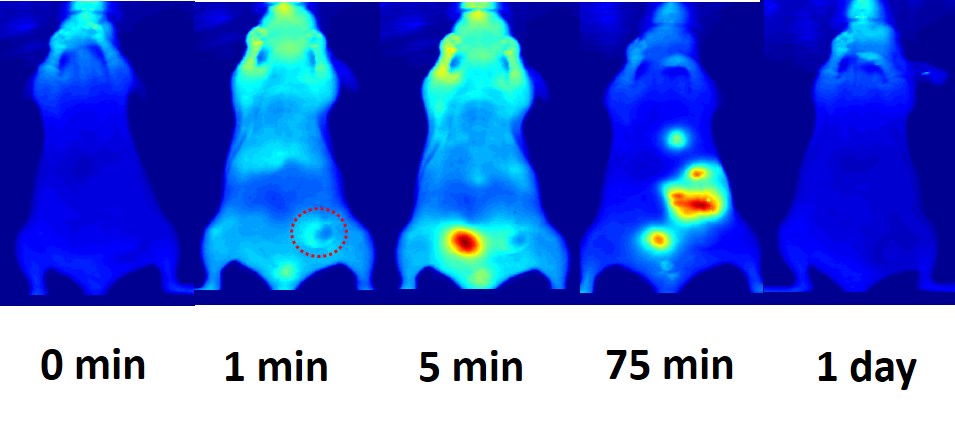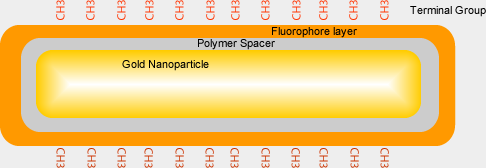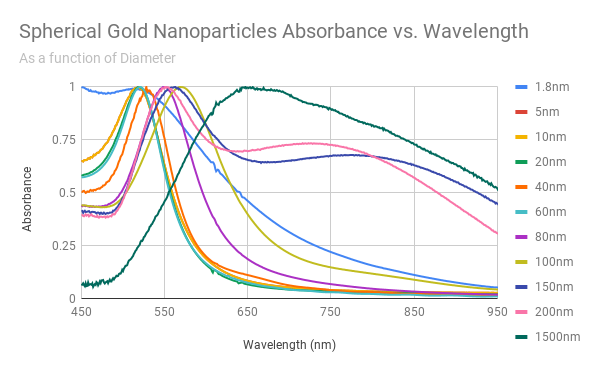Fluorophore Labeled Gold Nanoparticles
This technology utilizes the complete line of Accurate™ Spherical Gold Nanoparticles, Nanorods, Microgold™, and Gold Nanowires and allows the customer to choose the fluorophore and in vitro conjugation including amine, biotin, carboxyl, methyl, maleimide, neutravidin, streptavidin, and secondary antibody conjugations. These particles may also be conjugated to customer defined antibodies, peptides, oligos, and more. These conjugated particles can be used in brightfield, darkfield, fluorescence, and other imaging modes; and ELISA, lateral flow, and other assays. Although some fluorophores may be plasmonically enhanced by the correct choice of shape and sized gold nanoparticle, the designs allow for as many fluorophores as possible to be conjugated to each. Every batch is completely characterized including size, monodispersity, and concentration. A Certificate of Analysis (COA) is provided for every order exhibiting TEM and UV-VIS images and data, as well as DLS data.
FREE - These products, like all of our products, are BSA Free, Sodium Azide Free, and Glycerol Free
"Nanopartz is sublime for their broad range of high quality products, which are, as they truthfully describe on their website of excellent quality. The fluorescent gold nanoparticles I'm using in my research are perfect: high density, stable and high fluorescent efficiency, so they're making my nanoparticle microscopy study so much easier. Moreover, their technical support is the best I have ever encountered in a company, very patient and extremely helpful and friendly. Thank you! " Wieteke de Boer, PhD Departments of Biological Sciences and Neuroscience Columbia University |
| Diameter (nm) | Peak SPR Wavelength (nm) | NPS/ml | Molarity (pM) | Moles | Molar Ext. (M-1cm-1) | Size Dispersity %PDI | Size Accuracy (+/- nm) |
| 1.8 | n/a | 4.25E+16 | 7.10E+07 | 7.09E-08 | 7.05E+05 | <35% | 0.1 |
| 2.2 | n/a | 2.33E+16 | 3.90E+07 | 3.88E-08 | 1.29E+06 | <25% | 0.1 |
| 3 | n/a | 9.19E+15 | 1.50E+07 | 1.53E-08 | 3.26E+06 | <20% | 0.1 |
| 4 | n/a | 3.88E+15 | 6.50E+06 | 6.46E-09 | 7.74E+06 | <20% | 1 |
| 5 | 512 | 1.99E+15 | 3.30E+06 | 3.31E-09 | 1.51E+07 | <20% | 2 |
| 10 | 516 | 2.48E+14 | 4.10E+05 | 4.14E-10 | 1.21E+08 | <15% | 2 |
| 15 | 518 | 7.35E+13 | 1.20E+05 | 1.23E-10 | 4.08E+08 | <15% | 2 |
| 20 | 520 | 3.10E+13 | 5.20E+04 | 5.17E-11 | 9.67E+08 | <10% | 2 |
| 25 | 521 | 1.59E+13 | 2.60E+04 | 2.65E-11 | 1.89E+09 | <10% | 2 |
| 30 | 523 | 9.19E+12 | 1.50E+04 | 1.53E-11 | 3.26E+09 | <6% | 2 |
| 35 | 526 | 5.79E+12 | 9.60E+03 | 9.65E-12 | 5.18E+09 | <6% | 2 |
| 40 | 527 | 3.88E+12 | 6.50E+03 | 6.46E-12 | 7.74E+09 | <4% | 2 |
| 45 | 529 | 2.72E+12 | 4.50E+03 | 4.54E-12 | 1.10E+10 | <4% | 2 |
| 50 | 531 | 1.99E+12 | 3.30E+03 | 3.31E-12 | 1.51E+10 | <4% | 2 |
| 55 | 533 | 1.49E+12 | 2.50E+03 | 2.49E-12 | 2.01E+10 | <4% | 2 |
| 60 | 536 | 1.15E+12 | 1.90E+03 | 1.91E-12 | 2.61E+10 | <4% | 2 |
| 65 | 539 | 9.04E+11 | 1.50E+03 | 1.51E-12 | 3.32E+10 | <4% | 2 |
| 70 | 542 | 7.23E+11 | 1.20E+03 | 1.21E-12 | 4.15E+10 | <4% | 2 |
| 75 | 545 | 5.88E+11 | 9.80E+02 | 9.80E-13 | 5.10E+10 | <4% | 2 |
| 80 | 549 | 4.85E+11 | 8.10E+02 | 8.08E-13 | 6.19E+10 | <4% | 2 |
| 85 | 553 | 4.04E+11 | 6.70E+02 | 6.73E-13 | 7.42E+10 | <4% | 2 |
| 90 | 558 | 3.40E+11 | 5.70E+02 | 5.67E-13 | 8.81E+10 | <4% | 2 |
| 95 | 563 | 2.89E+11 | 4.80E+02 | 4.82E-13 | 1.04E+11 | <4% | 2 |
| 100 | 569 | 2.48E+11 | 4.10E+02 | 4.14E-13 | 1.21E+11 | <4% | 2 |
| 150 | 612 | 7.35E+10 | 1.20E+02 | 1.23E-13 | 4.08E+11 | <4% | 10 |
| 200 | n/a | 3.10E+10 | 5.20E+01 | 5.17E-14 | 9.67E+11 | <4% | 10 |
| 500 | n/a | 1.99E+09 | 3.30E+00 | 3.31E-15 | 1.51E+13 | <4% | 50 |
| 1000 | n/a | 2.48E+08 | 4.10E-01 | 4.14E-16 | 1.21E+14 | <4% | 100 |
| 1500 | n/a | 7.35E+07 | 1.20E-01 | 1.23E-16 | 4.08E+14 | <4% | 150 |
Optical Density >= 50, 2.5 for sizes >=500nm
|
Wt conc = 2.5mg/mL, 1mL volume typical
|
Wt % = 0.25%
|
| ppm = 2500 |
%PDI = Std Dev/Size
|
See Tech Note TN801 for definition of terms and method of analysis
|
All specs typical. May vary batch to batch. Exact values are measured for each batch
|
Shape monodispersity (% spheres) > 99.9%
|
Solution default is 18MEG DI water
|
Residual Chemicals < 0.1%
|
| Diameter (nm) | Length (nm) | Aspect Ratio | Peak SPR Wave (nm) | OD SPR (AU) | Peak LSPR Wave (nm) | OD LSPR (AU) | Nanorods /mL | Molarity (nM) | Moles | SPR Molar Ext. (M-1cm-1) | Peak SPR accuracy (nm) |
| 5 | 21 | 4.2 | 808 | 50 | 510 | 10 | 2.39E+14 | 398.72 | 3.99E-10 | 1.25E+08 | 794-829 |
| 5 | 19 | 3.8 | 780 | 50 | 510 | 10 | 2.67E+14 | 444.72 | 4.45E-10 | 1.12E+08 | 765-794 |
| 5 | 15 | 3 | 700 | 50 | 510 | 10 | 3.47E+14 | 578.14 | 5.78E-10 | 8.65E+07 | 675-725 |
| 10 | 175 | 17.5 | 2100 | 50 | 510 | 10 | 6.73E+12 | 11.21 | 1.12E-11 | 4.46E+09 | 1900-2300 |
| 10 | 102 | 10.2 | 1400 | 50 | 510 | 10 | 1.17E+13 | 19.47 | 1.95E-11 | 2.57E+09 | 1300-1500 |
| 10 | 81 | 8.1 | 1200 | 50 | 510 | 10 | 1.48E+13 | 24.67 | 2.47E-11 | 2.03E+09 | 1132-1300 |
| 10 | 67 | 6.7 | 1064 | 50 | 510 | 10 | 1.81E+13 | 30.13 | 3.01E-11 | 1.66E+09 | 1022-1132 |
| 10 | 59 | 5.9 | 980 | 50 | 510 | 10 | 2.09E+13 | 34.91 | 3.49E-11 | 1.43E+09 | 965-1022 |
| 10 | 55 | 5.5 | 950 | 50 | 510 | 10 | 2.22E+13 | 37 | 3.70E-11 | 1.35E+09 | 925-965 |
| 10 | 50 | 5 | 900 | 50 | 510 | 10 | 2.47E+13 | 41.11 | 4.11E-11 | 1.22E+09 | 875-925 |
| 10 | 45 | 4.5 | 850 | 50 | 510 | 10 | 2.78E+13 | 46.25 | 4.63E-11 | 1.08E+09 | 829-875 |
| 10 | 41 | 4.1 | 808 | 50 | 510 | 10 | 3.10E+13 | 51.68 | 5.17E-11 | 9.68E+08 | 794-829 |
| 10 | 38 | 3.8 | 780 | 50 | 510 | 10 | 3.36E+13 | 56.06 | 5.61E-11 | 8.92E+08 | 765-794 |
| 10 | 35 | 3.5 | 750 | 50 | 510 | 10 | 3.70E+13 | 61.67 | 6.17E-11 | 8.11E+08 | 725-765 |
| 10 | 29 | 2.9 | 700 | 50 | 510 | 10 | 4.44E+13 | 74 | 7.40E-11 | 6.76E+08 | 675-725 |
| 10 | 24 | 2.4 | 650 | 50 | 510 | 10 | 5.55E+13 | 92.5 | 9.25E-11 | 5.41E+08 | 625-675 |
| 10 | 19 | 1.9 | 600 | 50 | 510 | 10 | 7.40E+13 | 123.34 | 1.23E-10 | 4.05E+08 | 575-625 |
| 25 | 245 | 9.8 | 1400 | 50 | 514 | 15 | 1.12E+12 | 1.86 | 1.86E-12 | 2.69E+10 | 1232-1500 |
| 25 | 137 | 5.5 | 1064 | 50 | 514 | 15 | 2.05E+12 | 3.42 | 3.42E-12 | 1.46E+10 | 1022-1232 |
| 25 | 119 | 4.8 | 980 | 50 | 514 | 15 | 2.39E+12 | 3.98 | 3.98E-12 | 1.26E+10 | 965-1022 |
| 25 | 102 | 4.1 | 950 | 50 | 514 | 15 | 2.82E+12 | 4.7 | 4.70E-12 | 1.06E+10 | 925-965 |
| 25 | 96 | 3.8 | 900 | 50 | 514 | 15 | 3.01E+12 | 5.02 | 5.02E-12 | 9.95E+09 | 875-925 |
| 25 | 93 | 3.7 | 850 | 50 | 514 | 15 | 3.12E+12 | 5.2 | 5.20E-12 | 9.61E+09 | 829-875 |
| 25 | 90 | 3.6 | 808 | 50 | 514 | 15 | 3.24E+12 | 5.39 | 5.39E-12 | 9.27E+09 | 794-829 |
| 25 | 87 | 3.5 | 780 | 50 | 514 | 15 | 3.36E+12 | 5.6 | 5.60E-12 | 8.93E+09 | 765-794 |
| 25 | 85 | 3.4 | 750 | 50 | 514 | 15 | 3.45E+12 | 5.75 | 5.75E-12 | 8.70E+09 | 725-765 |
| 25 | 75 | 3 | 700 | 50 | 514 | 15 | 3.96E+12 | 6.61 | 6.61E-12 | 7.57E+09 | 675-725 |
| 25 | 71 | 2.8 | 650 | 50 | 514 | 15 | 4.22E+12 | 7.03 | 7.03E-12 | 7.11E+09 | 625-675 |
| 25 | 57 | 2.3 | 600 | 50 | 514 | 15 | 5.43E+12 | 9.05 | 9.05E-12 | 5.52E+09 | 575-625 |
| 25 | 34 | 1.4 | 550 | 50 | 514 | 15 | 1.01E+13 | 16.91 | 1.69E-11 | 2.96E+09 | 525-575 |
| 40 | 208 | 5.2 | 850 | 50 | 520 | 20 | 5.30E+11 | 0.88 | 8.84E-13 | 5.66E+10 | 1022-1232 |
| 40 | 180 | 4.5 | 850 | 50 | 520 | 20 | 6.19E+11 | 1.03 | 1.03E-12 | 4.84E+10 | 875-1022 |
| 40 | 148 | 3.7 | 850 | 50 | 520 | 20 | 7.67E+11 | 1.28 | 1.28E-12 | 3.91E+10 | 829-875 |
| 40 | 134 | 3.4 | 808 | 50 | 520 | 20 | 8.56E+11 | 1.43 | 1.43E-12 | 3.51E+10 | 794-829 |
| 40 | 124 | 3.1 | 780 | 50 | 520 | 20 | 9.33E+11 | 1.55 | 1.55E-12 | 3.22E+10 | 765-794 |
| 40 | 112 | 2.8 | 750 | 50 | 520 | 20 | 1.05E+12 | 1.74 | 1.74E-12 | 2.87E+10 | 725-765 |
| 40 | 92 | 2.3 | 700 | 50 | 520 | 20 | 1.31E+12 | 2.19 | 2.19E-12 | 2.29E+10 | 675-725 |
| 40 | 80 | 2 | 650 | 50 | 520 | 20 | 1.55E+12 | 2.58 | 2.58E-12 | 1.94E+10 | 625-675 |
| 40 | 68 | 1.7 | 600 | 50 | 520 | 20 | 1.89E+12 | 3.15 | 3.15E-12 | 1.59E+10 | 575-625 |
| 40 | 60 | 1.5 | 550 | 50 | 520 | 20 | 2.21E+12 | 3.69 | 3.69E-12 | 1.36E+10 | 525-575 |
| 50 | 245 | 4.9 | 1064 | 50 | 530 | 25 | 2.89E+11 | 0.48 | 4.82E-13 | 1.04E+11 | 980-1232 |
| 50 | 145 | 2.9 | 808 | 50 | 530 | 25 | 5.15E+11 | 0.86 | 8.58E-13 | 5.83E+10 | 750-850 |
| 50 | 110 | 2.2 | 700 | 50 | 530 | 25 | 7.08E+11 | 1.18 | 1.18E-12 | 4.24E+10 | 650-750 |
| 50 | 100 | 2 | 600 | 50 | 530 | 25 | 7.93E+11 | 1.32 | 1.32E-12 | 3.78E+10 | 550-650 |
| 70 | 150 | 2.1 | 600 | 50 | 530 | 25 | 2.66E+11 | 0.44 | 4.44E-13 | 1.13E+11 | 550-650 |
| 70 | 120 | 1.7 | 750 | 50 | 530 | 25 | 3.49E+11 | 0.58 | 5.81E-13 | 8.60E+10 | 700-800 |
| 70 | 105 | 1.5 | 650 | 50 | 530 | 25 | 4.13E+11 | 0.69 | 6.88E-13 | 7.27E+10 | 600-700 |
| 70 | 91 | 1.3 | 550 | 50 | 530 | 25 | 4.98E+11 | 0.83 | 8.30E-13 | 6.02E+10 | 500-600 |
SPR = Longitudinal SPR peak
|
LSPR = Transverse SPR peak
|
Shape monodispersity (% rods) > 95%
|
Size variation +/-10% (both dimensions)
|
wt. conc. = 1750 for diams <=10, 2500 for diams >=25nm
|
wt%=.175% for diams <=10, .25% for diams >=25nm
|
ppm=1750 for diams <=10, 2500 for diams >=25nm
|
| Diameter (nm) | Length (nm) | Aspect Ratio | Peak SPR Wave (nm) | SPR OD (1cm) | Microgold /mL | Molarity (pM) | Moles | SPR Molar Ext. (M-1cm-1) |
| 75 | 500 | 6.7 | 510 | 0.25 | 6.18E+09 | 10.3 | 1.03E-14 | 2.43E+07 |
| 100 | 1000 | 10 | 510 | 0.25 | 1.71E+09 | 2.85 | 2.85E-15 | 8.78E+07 |
| 150 | 2000 | 13.3 | 510 | 0.25 | 3.76E+08 | 0.63 | 0.1 | 3.98E+08 |
SPR = Transverse SPR peak
|
Shape monodispersity (% rods) > 95%
|
Size variation +/-10% (both dimensions)
|
Wt. conc (mg/mL) = 0.25
|
Wt. %=0.025%
|
| PPM=250 |
| Diameter (nm) | Length (nm) | Aspect Ratio | Peak SPR Wave (nm) | Nanowires /mL | Molarity (pM) | SPR Molar Ext. (M-1cm-1) |
| 75 | 1000 | 13 | 510 | 3.01E+09 | 5.02 | 9.96E+06 |
| 75 | 2000 | 27 | 510 | 1.49E+09 | 2.48 | 2.02E+07 |
| 75 | 4000 | 53 | 510 | 7.39E+08 | 1.23 | 4.06E+07 |
| 75 | 6000 | 80 | 510 | 4.91E+08 | 0.82 | 6.10E+07 |
| 75 | 10000 | 133 | 510 | 2.94E+08 | 0.49 | 1.02E+08 |
| 100 | 20000 | 200 | 510 | 8.27E+07 | 0.14 | 3.63E+08 |
SPR = Transverse SPR peak
|
Shape monodispersity (% wires) > 95%
|
Size variation +/-10% (both dimensions)
|
Wt. conc.= 250 ug/mL
|
Wt. % = 0.025%
|
| PPM=250 |
Fluorophore Labeled functionalized gold nanoparticle with Nanopartz covalently bonded polymer
Loading Range (/nm2)
|
Charge (mV) | |||
| Smaller particles | Larger particles | Smaller particles | Larger particles | |
PEG |
3 |
1 |
-27 |
-12 |
Alkyne |
2 |
2 |
-25 |
-25 |
Amine |
2 |
2 |
-20 |
20 |
Azide |
2 |
2 |
-25 |
-25 |
Biotin |
3 |
1.5 |
-25 |
-15 |
Carboxyl |
3 |
2 |
-38 |
-45 |
Methyl |
3 |
2 |
-27 |
-12 |
Streptavidin |
0.008 |
0.008 |
-25 |
-10 |
Neutravidin |
0.008 |
0.008 |
-25 |
-10 |
GSH (Glutathione) |
3 |
1.5 |
-25 |
-15 |
Protein A |
0.04 |
0.04 |
-25 |
-10 |
Protein G |
0.04 |
0.04 |
-25 |
-10 |
Maleimide |
2 |
1 |
-27 |
-12 |
NHS |
2 |
1.5 |
-25 |
-15 |
Hydroxyl |
2 |
2 |
-27 |
-12 |
Thiol |
2 |
2 |
-30 |
-30 |
Galactose |
2 |
2 |
-30 |
-30 |
Mutab |
4 |
3 |
30 |
40 |
IgG |
0.003 |
0.02 |
0.02 |
0.02 |
Wavelength (nm) |
Name | Excitation (nm) | Emission (nm) | Ext. Coef | QY | MW |
| 405 | AF405 | 402 | 421 | 1000 | ||
| Dy405 | 400 | 420 | ||||
| 488 | FITC | 494 | 518 | 70000 | 389 | |
| Dy488 | 493 | 518 | 70000 | |||
| AF488 | 490 | 525 | ||||
| GFP | 488 | 509 | ||||
| 532 | Rhodamine | 535 | 575 | 479 | ||
| 550 | Cy3 | 555 | 570 | 150000 | 0.31 | 590 |
| Dy550 | 562 | 576 | ||||
| AF555 | 555 | 580 | ||||
| AF568 | 578 | 603 | ||||
| 600 | Cy3.5 | 591 | 604 | 116000 | 0.35 | 741 |
| Dy594 | 593 | 618 | ||||
| AF594 | 590 | 617 | ||||
| Texas Red | 592 | 614 | ||||
| 633 | AF633 | 621 | 639 | 159000 | 1200 | |
| 650 | Cy5 | 646 | 662 | 250000 | 0.2 | 761 |
| Dy 650 | 652 | 672 | ||||
| AF647 | 650 | 665 | ||||
| 680 | Cy5.5 | 673 | 707 | 209000 | 0.2 | 767 |
| Dy680 | 682 | 715 | ||||
| AF680 | 679 | 702 | ||||
| 750 | Cy7 | 750 | 773 | 199000 | 0.3 | 733 |
| Dy755 | 754 | 776 | 220000 | |||
| AF750 | 749 | 775 | ||||
| 800 | Cy7.5 | 778 | 797 | 223000 | 833 | |
| Dy800 | 777 | 794 | 953 | |||
| Indocyanine green (ICG) | 788 | 813 |
Composition
These nanoparticles are shipped in 18MEG DI water (default solution) with no measurable residual reactants.
Custom Formulation
Please contact us.
Quantity
This product is available in 1mL volumes and larger.
Introductory Kits
Please contact us.
Shelf Life
Three months. Please go here for more information on our shelf life definition: Gold Nanoparticle Expiration Dates
Delivery
Standard sizes are in stock. Special order sizes are shipped in two weeks or less. All domestic shipments are sent Fed Ex Standard Overnight delivery, international Fed Ex Priority 2 day. No shipments on Fridays except for dried particles. Saturday shipping available for extra charge.
Functionalization
This product comes with a number of different covalent options.
Shelf Life/Storage Temperature
This product is guaranteed for six months and should be stored at 4 °C after opening. Care must be taken to only use sterile glassware when working with this product.
Toxicity
This product is known to be noncytotoxic. This product has been sterilized and is biological free.
Sterilization
This product is sterilized.
For post sterilization testing, please choose Sterilization Certification.
For endotoxin purification, choose Endotoxin Purified.
Certifications
Every order comes with a Certification of Analysis that includes the following information. We use calibration traceable:
UV-VIS (Agilent 8453) for extinction and concentration measurements
NIR (Cary 500) for NIR extinction and concentration measurements
DLS (Malvern Nano ZS) for zeta potential measurement
ICP-MS (Varian 820-MS) for gold mass measurements
TEM (Phillips CM-100 100KV) for sizing
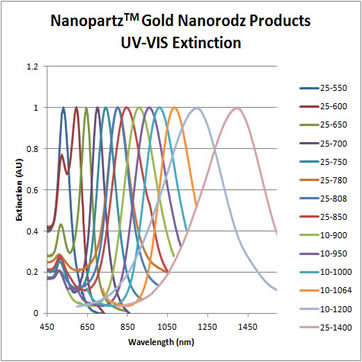
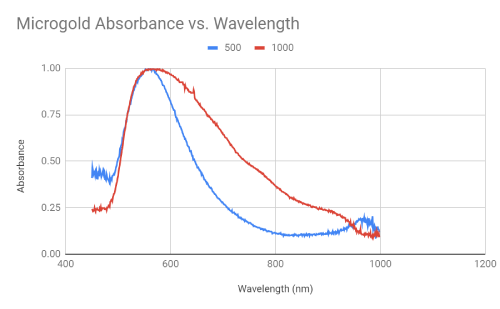
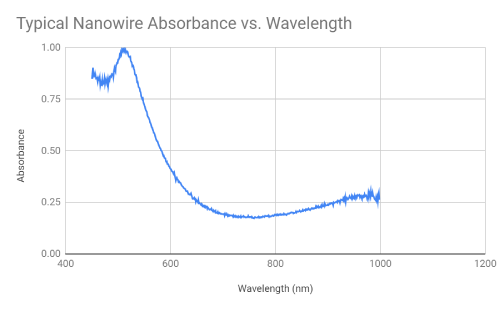
How much thickness does your proprietary capping agent add?
Anywhere from 1-5nm.
How do I determine the concentration of the product?
Simply divide the number of nanoparticles (nps) found on the included COA by the amount of solution you add.
Why do you sell your rods as OD-mLs and what does this mean?
This is because unlike spherical gold nanoparticles, the conversion from OD to mg is not linear with nanorod diameter. Consequently, for the same OD, the weight of the nanorods increases with diameter. 50 OD-mLs means that if you resuspend the material in 1mL of solvent, you will have an absorption of OD50 through a 1mL optical path.
Can I resuspend in water?
Yes
Can I suspend in silicon oil?
No
What is the shelf life if I never open the package and keep refrigerated?
Many years.
Should I store in the refrigerator?
Yes.
How do you size your gold nanoparticles? Does the size include the capping agent?
We use three methods to specify our gold nanoparticles; TEM, UV VIS, and DLS. Each has its own advantages and disadvantages, and we use a weighted system to take advantage of each methods strengths. In the end, we place the strongest weight to the TEM method, particularly since we use samples sizes greater than 50 particles for each lot.
Do you really provide a TEM for my specific lot?
Yes, and not just for 5-10 particles, rather 50-100 are standard.
Why are your small gold nanoparticles colored? I have seen 2nm particles on other website that look as clear as water.
All gold nanoparticles absorb and/or scatter. If you can't see them, then they probably aren't there.
What is OD?
Optical Density (OD) is measured by UV-VIS. An Optical Density OD=1 corresponds to a transmission of 10% through a 1cm cuvette. Optical Density is a nice unit to use since Optical Densities correlate linearly to concentration. So an Optical Density of 1.2 is equal to 1.2 times the concentration of a gold nanoparticle solution that has an Optical Density of 1. We use OD and concentration interchangingly as it is easier to refer to a solution of OD=1 rather than 2.35e12 nanoparticles. For all spheres up to 200nm, OD=1 does refer to 0.05mg/mL.
What is PDI?
PDI refers to polydispersity index and is equal to the standard deviation of the particle sizes divided by the average size.
How does your polymer bridge compare to PEG?
It is superior in its resistance to salt, pH, and other chemicals.
"We have looked at many different gold nanoparticles samples from Nanopartz including spheres, rods, and microrods using single particle spectroscopy techniques and are extremely happy with the quality of the samples and the service provided by Nanopartz."
Stephan Link, PhD
Assistant Professor of Chemistry
Rice University
Detectability of fluorescent gold nanoparticles under micro-CT and optical projection tomography imaging
To investigate the use of fluorophore-labeled gold nanoparticles, it is essential to consider the binding properties of DNA functionalized gold nanoparticle probes and molecular fluorophore probes (Lytton-Jean & Mirkin, 2005). Oligonucleotide functionalized gold nanoparticles have become the basis for various diagnostic applications, competing with molecular fluorophores in certain settings (Lytton-Jean & Mirkin, 2005). Additionally, super-resolution fluorescence imaging techniques have been applied to study fluorescently labeled ligands bound to the surface of gold nanoparticles in solution (Blythe & Willets, 2015). This is crucial as it provides insights into the behavior of fluorophore-labeled ligands in the presence of gold nanoparticles.
Moreover, the real-time identification and tracking of gold nanoparticles in free-flowing vasculature had not been possible without extrinsic labels such as fluorophores (Burkitt et al., 2020). This highlights the potential for using fluorophore-labeled gold nanoparticles in biomedical applications, particularly for tracking nanoparticles in biological systems. Furthermore, the incorporation of fluorophores into gold nanoshells has been reported to considerably enhance resistance to photobleaching (Pellegrotti et al., 2014). This is significant for ensuring the stability and longevity of the fluorescence signal in applications involving gold nanoparticles and fluorophores.
In addition, the use of fluorophore-labeled aptamer probe functionalized gold nanoparticles has been demonstrated for noninvasive and highly selective monitoring of intracellular glucose (Tang et al., 2017). This showcases the potential for utilizing fluorophore-labeled gold nanoparticles in biosensing and bioimaging applications. Furthermore, the controlled reduction of photobleaching in DNA origami–gold nanoparticle hybrids has been reported, indicating the potential for enhancing the photostability of fluorophores in the presence of gold nanoparticles (Pellegrotti et al., 2014).
It is also important to consider the interaction between fluorophores and gold nanoparticles. For instance, the direct attachment of fluorophores to gold nanoparticles may result in the quenching of the fluorescent signal due to resonant energy transfer (Miles et al., 2017). This suggests that the proximity and attachment of fluorophores to gold nanoparticles can significantly impact the fluorescence signal, which is crucial to consider in the design of nanoparticle-fluorophore conjugates.
Moreover, the enhanced fluorescence signals in patterned nanoporous gold nanoparticles make them a viable material for further reducing detection limits for biomolecular targets used in clinical assays (Santos et al., 2015). This highlights the potential for utilizing nanoporous gold nanoparticles in conjunction with fluorophores for sensitive detection applications.
In summary, the literature provides valuable insights into the use of fluorophore-labeled gold nanoparticles, including their binding properties, tracking capabilities, photostability, and potential applications in biosensing and bioimaging. Understanding the interaction between fluorophores and gold nanoparticles is crucial for optimizing their performance in various biomedical and diagnostic applications.
Blythe, K. and Willets, K. (2015). Super-resolution imaging of fluorophore-labeled dna bound to gold nanoparticles: a single-molecule, single-particle approach. The Journal of Physical Chemistry C, 120(2), 803-815. https://doi.org/10.1021/acs.jpcc.5b08534
Burkitt, S., Mehraein, M., Stanciauskas, R., Campbell, J., Fraser, S., & Zavaleta, C. (2020). Label-free visualization and tracking of gold nanoparticles in vasculature using multiphoton luminescence. Nanomaterials, 10(11), 2239. https://doi.org/10.3390/nano10112239
Lytton-Jean, A. and Mirkin, C. (2005). A thermodynamic investigation into the binding properties of dna functionalized gold nanoparticle probes and molecular fluorophore probes. Journal of the American Chemical Society, 127(37), 12754-12755. https://doi.org/10.1021/ja052255o
Miles, B., Greenwood, A., Benito-Alifonso, D., Tanner, H., Galan, M., Verkade, P., … & Gersen, H. (2017). Direct evidence of lack of colocalisation of fluorescently labelled gold labels used in correlative light electron microscopy. Scientific Reports, 7(1). https://doi.org/10.1038/srep44666
Pellegrotti, J., Acuna, G., Puchkova, A., Holzmeister, P., Gietl, A., Lalkens, B., … & Tinnefeld, P. (2014). Controlled reduction of photobleaching in dna origami–gold nanoparticle hybrids. Nano Letters, 14(5), 2831-2836. https://doi.org/10.1021/nl500841n
Santos, G., Zhao, F., Zeng, J., Li, M., & Shih, W. (2015). Label‐free, zeptomole cancer biomarker detection by surface‐enhanced fluorescence on nanoporous gold disk plasmonic nanoparticles. Journal of Biophotonics, 8(10), 855-863. https://doi.org/10.1002/jbio.201400134
Tang, J., Ma, D., Pecic, S., Huang, C., Zheng, J., Li, J., … & Yang, R. (2017). Noninvasive and highly selective monitoring of intracellular glucose via a two-step recognition-based nanokit. Analytical Chemistry, 89(16), 8319-8327. https://doi.org/10.1021/acs.analchem.7b01532
| Nanopartz Fluorophore Labeled Gold Nanoparticles | |
| Stability (salt,pH,chemicals) | High |
| Monovalent | Yes |
| Nonspecific binding | Very low |
| Sterilization | Yes |
- Covalent bonds insure specificity, stability, long shelf life
- Buffer Stability - stable from pH 4-9
- No sodium azide
- No BSA
- Polymer coating insures no aggregation in high salts, reduced nonspecific binding
- Stable
- Well Characterized
- Customer can select buffer
- Customer can select gold nanoparticle type, size and/or SPR
- Loading of all ligands is optimized
Example part number is CF11-10-488-FZ-DIH-50-1-CS-EP where:
CF11 - Product family number for Fluorophore Labeled Spherical Gold Nanoparticles. For Gold Nanorods, its CF12 and so forth.
10 - Sphere diameter in nanometers. Other choices are 1.8 to 1500
488 - Fluorophore. For a complete list go here Fluorophore List.
FZ - Covalent ligand, in this case Azide.
DIH - Buffer, in this case 18MEG DI water. Other choices are PBS, MES, Sodium Borate, TRIS
50 - Optical Density, in this case OD=50, optional 250
1 - Volume (mL). Other choices are 5mL, 10mL and more.
CS - Certified Sterilized - Though the product come sterilized, this option includes testing and certification.
EP - Endotoxin Purified - The product is endotoxin purified and certified.
Ordering by scrolling down and selecting the options from the selection below.

